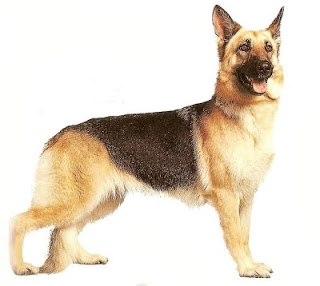The German Shepherd Dog (GSD, also known as an Alsatian), (German: Deutscher Schäferhund) is a breed of large-sized dog that originated in Germany
Description
When the UK Kennel Club first accepted registrations for the breed in 1919, fifty-four dogs were registered, and by 1926 this number had grown to over 8,000. The breed first gained international recognition at the decline of World War I after returning soldiers spoke highly of the breed, and animal actors Rin Tin Tin and Strongheart popularised the breed further. The first German Shepherd Dog registered in the United States
Popularity increased again after the German Shepherd Sieger Pfeffer von Bern became the 1937 and 1938 Grand Victor in American Kennel club dog shows, only to suffer another decline at the conclusion of World War II, due to anti-German sentiment of the time. As time progressed, their popularity increased gradually until 1993, when they became the third most popular breed in the United States US
Popularity
German Shepherds are a medium sized dog which generally are between 55 and 65 centimetres (22 and 26 in) at the withers and weigh between 22 and 40 kilograms (49 and 88 lb). The ideal height is 63 centimetres (25 in), according to Kennel Club standards. They have a domed forehead, a long square-cut muzzle and a black nose. The jaws are strong, with a scissor-like bite. The eyes are medium-sized and brown with a lively, intelligent, and self-assured look. The ears are large and stand erect, open at the front and parallel, but they often are pulled back during movement. They have a long neck, which is raised when excited and lowered when moving at a fast pace. The tail is bushy and reaches to the hock.
German Shepherds can be a variety of colours, the most common of which are the tan/black and red/black varieties. Both varieties have black masks and black body markings which can range from a classic "saddle" to an over-all "blanket." Rarer colour variations include the sable, all-black, all-white, liver, and blue varieties. The all-black and sable varieties are acceptable according to most standards; however, the blue and liver are considered to be serious faults and the all-white is grounds for instant disqualification in some standards. This is because the white coat is more visible, making the dog a poor guard dog, and harder to see in conditions such as snow or when herding sheep.
German Shepherds sport a double coat. The outer coat, which is shed all year round, is close and dense with a thick undercoat. The coat is accepted in two variants; medium and long. The long-hair gene is recessive, making the long-hair variety rarer. Treatment of the long-hair variation differs across standards; they are accepted under the German and UK Kennel Clubs but are considered a fault in the American Kennel Club.
Intelligence
German Shepherds were bred specifically for their intelligence, a trait for which they are now renowned. They are considered to be the third most intelligent breed of dog, behind Border Collies and Poodles. In the book The Intelligence of Dogs, author Stanley Coren ranked the breed third for intelligence. He found that they had the ability to learn simple tasks after only five repetitions and obeyed the first command given 95% of the time. Coupled with their strength, this trait makes the breed desirable as police, guard, and search and rescue dogs, as they are able to quickly learn various tasks and interpret instructions better than other large breeds.
.jpg)



